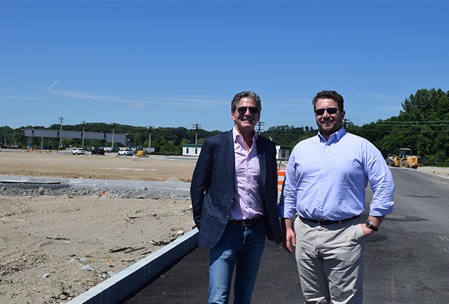June 23, 2018
$1B waterfront development in Sleepy Hollow edges forward
Aleesia Forni
Westfair Online
On a recent scorching June afternoon, Diversified Realty Advisors founding partner Jonathan Stein walked to his black SUV and emerged with an item that resembled an oversized, silver briefcase. He placed it on the floor of his car, opened it up and pulled out a white drone. Using his iPhone as a means of controlling the device, he planned to use the drone to capture a series of photos of a 67-acre site that was once home to a General Motors assembly plant in Sleepy Hollow.
Today, the property is dotted with heavy equipment and construction crews, all working to transform the waterfront parcel into a sprawling mixed-use development known as Edge-on-Hudson.
When asked whether he uses the drone photos for marketing purposes or to show to prospective residents or tenants of Edge-on-Hudson, Stein replied, “No, I just like to track our progress.”

Jonathan Stein and Peter Chavkin. Photo by Aleesia Forni.
It’s easy to understand why Stein has such an interest in the progress of the project that sits just off Beekman Avenue. It’s one he’s been involved in for more than two decades.
“It has been a long journey,” said Stein, whose company is part of the joint venture developing the site. “But the site really speaks for itself. It’s a unique opportunity.”
Stein was approached by GM officials regarding the development of the site in 1998. At the time, Stein was a partner at Roseland Property Co., the New Jersey company that was later chosen to redevelop the property in 2001.
But lawsuits, the recession and GM’s bankruptcy reorganization all worked to delay the project for years, and Roseland and General Motors parted ways on the project in 2007.
In 2012, General Motors reached out again to Stein, this time at his new company, Diversified Realty, to see if he would be interested in participating in its new request for proposals from developers. After the automaker completed an environmental cleanup of the industrially contaminated site in 2013, a joint venture of Diversified Realty and SunCal, a California developer of residential and commercial properties, bought the site for $39.5 million.
“I think it’s worthwhile and it’s finally coming to fruition,” Stein said.
Ultimately, Edge-on-Hudson is expected to include 1,177 units of condominiums, townhouses and rental apartments; a 140-room boutique hotel; 135,000 square feet of retail space and 35,000 square feet of office space.
Though the estimated $1 billion project broke ground in May 2016, the developers admit that from the public’s eye, the site’s progression may not seem so apparent. Still, Stein and Peter Chavkin, lead development consultant with SunCal, are enthusiastic about how far the development has come.
“So much work goes in on the front end,” said Chavkin, who said he first set foot on the property in 2011. “We feel like we’re making great progress.”
Most of 2017 was spent installing the infrastructure that would support the first phase of development, including importing more than 200,000 cubic yards of fill to raise the site and constructing a roadway and roundabout on the property. Paved roads and curbs have also been installed in recent months.
At press time, the developers were awaiting approvals from the village to start on the second phase of the project, which will include additional infrastructure work along the waterfront parcel.
“It’s taking shape finally to the point where a lay person would notice a difference,” Stein said.
The development will also feature more than 16 acres of parkland and a promenade along the water. Recently, the developers moved the site’s boundary away from the coastline, moving a chain-length fence farther away from the waterfront of the property. That move allowed for a public walkway that links the existing riverwalk to the south and Kingsland Point Park to the north, one that was both popular on a recent summer day and also part of the running portion of the Sleepy Hollow Triathlon.
“It’s not just going to be for our residents,” Chavkin said of Edge-on-Hudson. “It’s for the village of Sleepy Hollow.”
In the future, that walkway will be lined with four to five restaurants, the developers said, offering outdoor seating and views of the river and newly constructed Mario M. Cuomo Bridge.
“It should be a destination where people from across the region can come and enjoy and spend their food and beverages dollars,” Chavkin said.
The transit-oriented development, which is less than a mile from both the Philipse Manor and Tarrytown Metro-North stations, will likely attract residents who may have been priced out of New York City, Stein said. There will also be free shuttles available to take residents from the development to the Tarrytown train station.
“What we’re trying to do is offer a new take on suburban life,” Chavkin said.
Earlier this year, the joint venture announced that Toll Brothers, a 50-year-old Fortune 500 company based in Pennsylvania, signed an agreement to purchase and build out lots as part of the project’s first phase. Development on the 24-acre western parcel of the site will include as many as 306 units of housing, including 61 units of affordable, senior and workforce housing.
The company has already brought onto the property structures that will be used to display model units of the homes that will later be built on the property. A spokesperson for Toll Brothers said the company is set to break ground on the project this fall, and the first residents could move in next summer.
To the east of the site, the developers have been at work for nearly two years building a bridge on Beekman Avenue. That bridge is expected to open later this summer.
“There’s an excitement among local residents about this,” Stein said of the development. “It’s palpable, and it’s building.”


